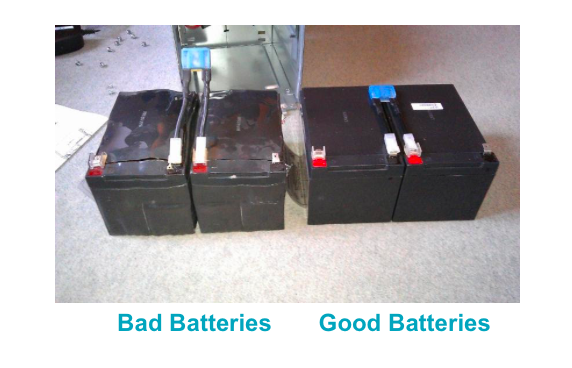Blog
Automated Power Blog
By user_upsprotection
•
13 Jun, 2019
Lithium-Ion Batteries are becoming more popular in UPS systems. Originally they were tried in small UPS systems but now are also being used in larger data center UPS systems. Although the use of Lithion-Ion Batteries is becoming more popular for UPS systems, lead-acid batteries are still dominant after being used successfully for years. The Advantages Lithium-Ion Batteries have advantages over valve regulated Lead Acid Batteries currently used in UPS systems. Longer Life Span up to 10- 15 years vs 3 to 5 years, meaning lower Total Cost of Ownership (TCO) Smaller size and weight Less sensitive to temperature fluctuations Faster Recharge times Higher Energy Density The Disadvantages While there are many advantages, there are still some significant drawbacks. Current cost is still high (1.5 to 10 times more) Must be carefully managed to reduce the potential for Thermal Runaway. Can not be retrofitted into existing Lead Acid applications Battery Management Systems must be used (which can also be a benefit) Tighter restrictions and costs for transportation Other Considerations If a slightly higher initial price for your UPS is not a stumbling block and Total Cost of Ownership is most important then a Litium-Ion UPS maybe the solution. Some manufacturers are guaranteeing the batteries for the life of the UPS which could be 10 to 15 years. One less thing to worry about. Examples: APC introduced their SmartUPS 1500 with Li-Ion batteries: A space saving UPS with its small depth ideal for wall mount or tight installation locations. The Lithium-Ion batteries allow for smaller sizes and faster recharge rates. Also battery life of 5 to 10 years. SmartUPS 1500 Eaton Mid Size 3 phase UPS: The Eaton 93PM UPS combines efficiency, reliability, and vertical or horizontal scalability. Available in sizes from 10KW to 400KW. A space-saving, flexible device that’s as easy to deploy as it is to manage. Eaton 93PM Large 3 phase Liebert NXL: The Liebert® NX™ UPS provides high efficiency in both Eco-mode and double conversion mode, higher availability with hot-rectifier operation, and flexibility with SoftScale capacity upgrades. Available in sizes from 250kVA to 1100kVA. Liebert NXL Contact the experts at UPS Protection/Automated Power for more information on Data Center, Data Rooms, Telecom Closets or other critical applications requiring power backup. click here or call 800.755.0080. UPS Protection also designs, sells and services Data Center Infrastructure products from APC, Liebert, Eaton, Generac and other major brands.
By user_upsprotection
•
12 Jun, 2019
The Need for Energy Storage Do we need storage? The simple answer is yes! But we must break down the different uses to determine how important energy storage really is. Here is a list of the most common uses: Utility Level- Mass storage to augment electrical supply at peak demand Commercial- Storage in conjunction with solar to peak shave high demand times or to supply electricity during a power outage Residential- Used in conjunction with solar to provide backup power during a utility outage or to have batteries provide power during high rate times and recharge during low rate periods like night time Universal Residential- Mandated storage at residential level which smooths and balances electrical requirements saving the utilities from having to build new power plants Utilities Much research and development is going into utility level energy storage using various types of batteries, hydroelectric from rivers and dams, thermal storage, compressed air, flywheels and super capacitors. The most research appears to be going into different types of batteries. This includes large banks of small batteries like lithium-ion to very large single cell batteries using various types of dialectrics such as salt water. These devices can store into the Megawatt range making them very useful for smoothing peak cycle requirements of utility power. Utilities are implementing large scale energy storage in many locations. By utilizing stored energy at peak demand, they can eliminate the need to build addition generating plants. New power plants are very expensive and must go through a mountain of red tape to meet environmental regulations. Commercial One of the most economical uses of battery storage is for peak shaving at commercial facilities. Unlike residential billing, commercial users are billed based on their peak demands during the prior year. This peak demand sets the Kilowatt per hour rate for the future. Lowering the peak demand lowers the rate and therefore the entire bill for the following year. Energy storage systems will automatically supply power during high usage times like mid-afternoon when air conditioners are working hard and production is in full swing. Batteries are then recharged by lower cost electricity at night or by solar arrays. By utilizing the stored energy at these peak times reduces the peak demand and the rate for the entire year. This system can also provide backup power during a utility failure. Return on investment (ROI) for these systems is usually very good. Residential: Less economical but certainly good for the environment is a residential battery storage system used in conjunction with a solar system. These systems can be cost effective in areas where the rate is high for kilowatt hours. These can be justified in several ways: Photo-Voltaic (PV) Self Consumption: This system is designed to provide all or most of the power for the residence. Excess solar energy produced is stored in batteries. This stored energy is used during the night and times of low solar production. This keeps the costs from purchased energy to a minimum. Time of Use (TOU): When the utility bills by TOU, your rate changes during the day with the most expensive power available during peak afternoon and early evening. By using the the battery system in conjunction with the solar panels to power the house during these high cost times, overall utility costs can be kept to a minimum. Universal Residential: This system requires all residential users to have battery based energy storage tied to their home utility. The systems are either supplied by the government or the utility companies. These smart storage devices are all connected and can work independently or controlled as a group by the power company to supply power back into the grid during times of peak demand. This could eliminate the need for additional power plants and quickly justifies the initial cost. Summary This market is growing rapidly with many new technologies becoming available. If you are interested in more information check out these websites: “Residential Energy Storage Economics” By:Matthias B. Krause, David Brearley July/Aug 2016 printed on SolarPro website “When Does Energy Storage Make Sense?” February 25, 2018 by Lars Lisell printed on NREL website.
By user_upsprotection
•
12 Jun, 2019
Fire Storms: As I write this, California is on fire! Thousands of people are currently at risk of losing their homes and businesses to the flames. Fires are becoming more destructive and unpredictable. There are power outages throughout the area including local businesses, hospitals, and industry. It will take days to get much of the power back on. Fires not only cause destruction but also create environmental hazards from the toxic smoke that fills large areas. It makes air unhealthy to breathe for humans but also damaging to data center equipment by clogging the air filters for computers, backup power systems and air conditioning units. This can cause damage days or even weeks after the event.

By user_upsprotection
•
23 Jun, 2018
Battery Failure is the most common problem that data center professions face with their physical infrastructure. With proper maintenance costly down time can be avoided. Otherwise this can happen: Watch this video of what can and often does happen in the data center- Data Center Fire . Who needs this kind of delay! Here are other examples of not following correct maintenance procedures:

By user_upsprotectio
•
11 Apr, 2018
Emergency Lighting Inverters ensure safe exit and continuation of critical operations! Routine service is necessary to make sure they work when you need them! Centralized emergency lighting inverters are used to provide backup power to lighting systems for a minimum of 90 minutes in the event of a utility failure. Emergency lighting is required by law in areas where it is necessary for safe exit of buildings, parking garages, public arena’s and stadiums. Look for equipment that is UL 924 listed. It is also useful for critical areas that need to continue operations without interruption of lighting. Many times the end user may be unaware that they have these devices until there is a power failure and the inverters do not keep the lights on or they are cited during a fire or safety inspection. Many times they are installed in a back room or electrical closet. Service is often overlooked! To meet regulations and to ensure lighting during a power outage, these systems should be serviced twice a year by a reputable and experienced service organization. Call to schedule at 800-755-0800.

By user_upsprotection
•
09 Oct, 2016
There are several types of UPS systems each with their own unique advantages. Today we will describe two of the most common. The most small UPS systems, 150 to 3000VA are Line Interactive design. Larger systems will use an Online design but in many cases both are available. So which should you have?
- Mon - Thu
- -
- Friday
- -
- Sat - Sun
- Appointment Only
Content, including images, displayed on this website is protected by copyright laws. Downloading, republication, retransmission or reproduction of content on this website is strictly prohibited. Terms of Use
| Privacy Policy




